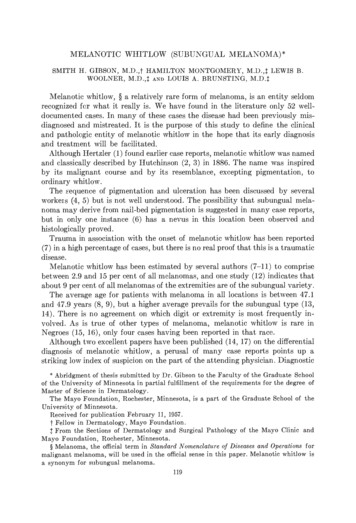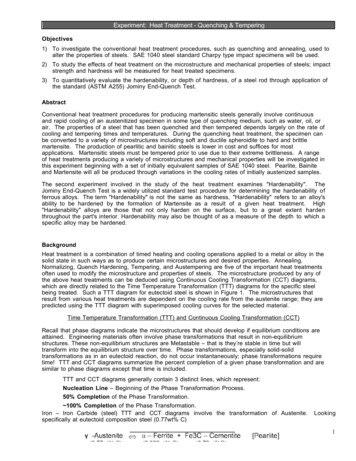
Transcription
MELANOTIC WHITLOW (SUBUNGUAL MELANOMA)*SMITH H. GIBSON, M.D.,F HAMILTON MONTGOMERY, M.D.4 LEWIS B.WOOLNER, M.D.,t AND LOUIS A. BRUNSTING, M.D.tMelanotic whitlow, § a relatively rare form of melanoma, is an entity seldomrecognized for what it really is. We have found in the literature only 52 welldocumented cases. In many of these cases the disease had been previously misdiagnosed and mistreated. It is the purpose of this study to define the clinicaland pathologic entity of melanotic whitlow in the hope that its early diagnosisand treatment will be facilitated.Although Hertzler (1) found earlier case reports, melanotic whitlow was namedand classically described by Hutchinson (2, 3) in 1886. The name was inspiredby its malignant course and by its resemblance, excepting pigmentation, toordinary whitlow.The sequence of pigmentation and ulceration has been discussed by severalworkers (4, 5) but is not well understood. The possibility that subungual melanoma may derive from nail-bed pigmentation is suggested in many case reports,but in only one instance (6) has a nevus in this location been observed andhistologically proved.Trauma in association with the onset of melanotic whitlow has been reported(7) in a high percentage of cases, but there is no real proof that this is a traumaticdisease.Melanotic whitlow has been estimated by several authors (7—11) to comprisebetween 2.9 and 15 per cent of all melanomas, and one study (12) indicates thatabout 9 per cent of all melanomas of the extremities are of the subungual variety.The average age for patients with melanoma in all locations is between 47.1and 47.9 years (8, 9), but a higher average prevails for the subungual type (13,14). There is no agreement on which digit or extremity is most frequently involved. As is true of other types of melanoma, melanotic whitlow is rare inNegroes (15, 16), only four cases having been reported in that race.Although two excellent papers have been published (14, 17) on the differentialdiagnosis of melanotic whitlow, a perusal of many case reports points up astriking low index of suspicion on the part of the attending physician. Diagnostic*Abridgment of thesis submitted by Dr. Gibson to the Faculty of the Graduate Schoolof the University of Minnesota in partial fulfillment of the requirements for the degree ofMaster of Science in Dermatology.The Mayo Foundation, Rochester, Minnesota, is a part of the Graduate School of theUniversity of Minnesota.Received for publication February 11, 1957.Fellow in Dermatology, Mayo Foundation.From the Sections of Dermatology and Surgical Pathology of the Mayo Clinic andMayo Foundation, Rochester, Minnesota.§ Melanoma, the official term in Standard Nomenclature of Diseases and Operations formalignant melanoma, will be used in the official sense in this paper. Melanotic whitlow isa synonym for subungual melanoma.119
120THE JOURNAL OF INVESTIGATIVE DERMATOLOGYcriteria have been delineated by many workers and are suggested in the numerouscase reports. These criteria might be summarized as follows: (1) a history orthe presence of any form of pigmentation in, under or about a single nail, especially if this pigmentation is increasing; (2) a history or the presence of chroniconychia, paronychia or granular excrescence that involves a single nail, that isessentially painless and that refuses to heal, or increases, despite all treatment;(3) a history or the presence of splitting, cracking or displacement of a singlenail, not readily explained by some other concurrent disease; and (4) any ofthe above changes developing and persisting for an unusual length of time following trauma.Simple surgical excision, or this combmed with dissection of the regionalnodes, is the treatment of choice for subungual melanoma (8, 12, 13, 18, 19).Most authors agree that melanoma is radioresistant, although this modality oftreatment is reported (20, 21) efficacious in some cases. There is little agreementconcerning the extent of surgical treatment indicated and the end results thatmay be attributed to it. Only a few reported cases have had adequate follow-upafter operation. Furthermore, older patients are likely to die of other causesbefore the malignant lesion can recur or metastasize. These factors make itimpossible to obtain significant prognostic figures. Therefore, information tobe of any value must be interpolated from more extensive studies dealing withmelanoma in general.Some workers (13, 14, 19) have ascribed a relatively good prognosis to melanotic whitlow, while one (11) has said that it is no less malignant than melanomain other locations and that all treatment is fruitless if metastasis has occurred.In one large general series (8), seven of 25 patients (28 per cent) with subungualmelanoma survived 5 years or longer. This was compared with a 5-year survivalrate of 19.7 per cent for all the melanoma patients of that series, but the difference was not considered statistically significant. Another study (22), in which18 patients with subungual melanoma had been treated surgically and followed,revealed that seven patients (38.9 per cent) survived at least 5 years withoutrecurrence. This was compared with a 5-year survival rate of 21.4 per cent forthe authors' over-all group. Elective prophylactic dissection of the nodes, ifdone, should be performed a few weeks after removal of the primary lesion,thus allowing the nodes to entrap any migrating malignant cells (18, 23). Thatsuch dissection enhances survival remains to be proved.Although doubt has been expressed (8) as to whether radical surgical proceduresoffer a greater chance for longer survival, some workers (22, 23) have advocatedsuch treatment for malignant melanoma. When a hand or foot is involved,with regional metastasis, one group (22) would disarticulate the entire extremitywith simultaneous removal of the nodes. The average survival time for theseauthors' general cases was longer after local excision than after radical procedures. A longer survival following simple excision has also been observed byothers (12). This paradox is probably explained on the grounds that more radicalprocedures are elected for the more advanced cases of malignancy.No special study of the histopathology of melanotic whitlow has been reportedin the literature.
MELANOTIC WHJTLOW (SUBUNGUAL MELANOMA)121PRESENT STUDYMaterial and method: The records of 40 patients with subungual melanoma, seen anddiagnosed at the Mayo Clinic from May 15, 1914, through September 15, 1955, were reviewed.Two eases had not been histologically proved and were excluded. For the remaining 38eases, data obtained from the ease records, from extensive follow-up efforts and from recentexaminations were summarized. For comparison, 52 well-documented eases were takenfrom the literature. These were abstracted and tabulated in detail elsewhere (see thesis, 24).All available pathologic material, gross and microscopic, was reviewed. Slides from 33of the 38 primary lesions, plus several preserved gross specimens, were available for study.Hematoxylin and eosin and silver nitrate stains were used. All characteristics that mightprove helpful in grading malignancy or in making a prognosis were noted. Special effortwas made to find some microscopic characteristics that might be peculiar to the cases inwhich the patients had enjoyed prolonged survival periods. In two suitable specimens thepigmented halo about the whitlow was studied in an attempt to ascertain its microscopicstructnre.Illustrative cases: In order to present the total clinical picture of melanoticwhitlow more effectively, abstracts of four cases are given.Case 1: A 50-year-old housewife came to the clinic on October 3, 1944, complaining ofbleeding from the left great toe. Small hemorrhages had been recurring for about 1 year,during which she had been treated for an ingrown nail. Part of the nail had spontaneouslyseparated during this time. Examination disclosed a walnut-sized, pigmented, granulomatous tumor involving the distal part of the toe and displacing the nail from its bed (fig.le). No nodes were palpated, and the x-ray appearance of the thorax was normal. The toewas amputated on October 9, and the pathologic report was malignant melanoma (fig. lb).At the next visit to the clinic 11 months later metastasis to the left inguinal region and toboth lungs had occurred. The patient died in July, 1946, a year and 9 months after operation.Except for pigmentation of the lesion, ingrowing nail might well have beendiagnosed. This case points to the difficulty in assessing prognosis at the time ofoperation in a case in which there is no clinical evidence of metastasis to thenodes.Case 2: A 46-year-old housewife was seen at the clinic on April 3, 1946, with the complaintof a bleeding, discharging lesion of the left thumb. Five years previously ridges had developed in the nail which split longitudinally. For many months an infection had persistedaround the nail. An occasional aching sensation had extended up the arm. Treatment hadbeen given for a fungous infection, and on at least one occasion the nail had been removed.Examination disclosed a nail fragment which was friable, piled-up, dystrophie, and bathedin pus. A band of pigment encircled the nail bed (fig. 2a). A node 1 cm. in diameter waspalpated in the left axilla. X-ray examinations of the thorax and of the digit gave negativeresults. The thumb was amputated on April 12, and the pathologic diagnosis was malignantmelanoma (fig. 2b). A "brain tumor" and other metastatic lesions developed and thepatient died in April, 1952, six years after operation.An earlier diagnosis might have been possible had the pigmented halo beenappreciated. The axillary nodes were not dissected even though one was enlarged.Whether or not the patient would have lived longer than 6 years with moreradical surgical treatment is problematical.Case 3: A 54-year-old clerk and housewife came to the clinic on March 17, 1954, complaining of an indolent ulcer of the right index finger. Nine months previously a blue line
122THE JOURNAL OF INVESTIGATIVE DERMATOLOGYFIG. 1 (case 1). a. Amputated specimen. Note upward displacement of nail and absenceof pigmentation in surrounding skin. b. Origin of melanoma from epithelium of nail bed isindicated by an X (hematoxylin and eosin; X100).Fra. 2 (case 2). a. Digit before operation showing band of pigmentation surroundingentire nail bed. b. Section through nail bed showing downward invasion and numerousmitotic figures (hematoxylin and eosin; X400).—resembling a pencil mark—bad appeared down the center of the nail of the finger. Thiswidened in the next 3 months to involve the entire nail plate. Three months before admission the nail had disintegrated and "proud flesh" protruded from the nail bed. The endof the finger became tender and swollen and it bled easily. On examination the nail bedcontained necrotic, hypertrophic, granular tissue. The major portion of the nail was missing, and the remnant, along with the entire distal phalanx, was darkly pigmented (fig. 3a).There were no palpable nodes, and x-ray examination of the thorax gave negative results.The finger was amputated on March 22, and pathologic examination of the specimen dis-
123USSMELANOTIC WHITLOW (SUBIJNGUAL MELANOMA)Fta. 3 (case 3). a. Digit before operation showing band of pigmentation extending proximally from nail bed. b. Section through nail bed showing junctional activity. Numerousmitotic figures are present (hematoxylin and eosin; X400). c. Section through pigmentedband of figure 3a showing lentigo structure (hematoxylin and eosin; X175). d. Higher magnification of figure 3c showing increased number of clear cells and several mitotic figures(hematoxylin and eosin; X400).closed malignant melanoma (fig. 3b). Within 5 months metastasis to supraclavicular andaxillary nodes had developed. The patient died of widespread melanoma in December,1954, nine months after operation.Apparently, the earliest sign in this case was either a lentigo or a junctionnevus. The pigmented band made the lesion classic for diagnosis. This lesion
THE JOURNAL OF INVESTIGATIVE DERMATOLOGYI.4.i,S!11S.4124FIG. 4 (case 4). a. Digit before operation showing pigmentation extending from peripheryof nail bed. 6. Section through nail bed at lateral nail fold showing origin from epitheliumof nail bed (hematoxylin and eosin; X100). c. Section from pigmented band of figure 4ashowing junctional activity and invasion (hematoxylin and eosin; X200).relatively young, manipulations had not been done, and there was no indication of metastasis. Yet, a very malignant course is demonstrated for a case inwhich a better outcome might reasonably have been expected.wasCase 4: A 65-year-old farm wife came to the clinic on July 15, 1954, complaining ofsoreness of the right index finger. About 10 years previously she had noted black stripesbeneath the nail. These gradually widened to cover the entire plate. Six months previouslypart of the nail had been removed, and 2 months later the nail bed was purulent. Withinthe previous few months the skin beneath the distal part of the nail had turned black.Examination revealed a dark, brownish-gray nail remnant, the pigmentation extendingover the distal tip of the finger (fig. 4a). A small, firm, movable node was palpated in theright axilla, but a roentgenogram of the thorax showed no evidence of metastasis. The fingerwas amputated on July 21, and nodes were removed from the axilla for diagnosis. Pathologic examination of the nail bed disclosed malignant melanoma (fig. 46) but only an inflammatory reaction was found in the nodes. The patient was still living and in good health2 years after operation.In this case the earliest lesion was evidently a subungual nevus, and theincreased pigmentation might have suggested activity or malignant change.Only inflammatory changes were found in the nodes of the axilla, althoughmetastatic tumor had been fully expected.Histopathol
The Mayo Foundation, Rochester, Minnesota, is a part of the Graduate School of the University of Minnesota. Received for publication February 11, 1957. Fellow in Dermatology, Mayo Foundation. From the Sections of Dermatology and Surgical Pathology of the Mayo Clinic and Mayo Foundation, Rochester, Minnesota. § Melanoma, the official term in Standard Nomenclature of Diseases and










